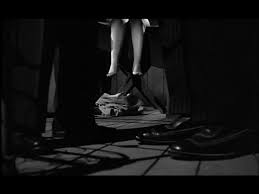There are few films as hard-boiled as Robert Aldrich’s Kiss Me Deadly, based on the Mickey Spillane novel of the same name (but with a comma after “Kiss Me”). Ralph Meeker’s Mike Hammer is a handsome young thug who does not shrink at dispensing excruciating pain or administering summary execution. The movie is fairly close to the spirit of the novel, with one major difference. What Spillane’s private eye is looking for is some kind of drug; Aldrich instead made it some kind of radioactive material that explodes when mixed with air. Also, the film is set in Los Angeles rather than New York; and it uses the change of scene to advantage.
As the villainous Dr. Soberin (Albert Dekker) says to Hammer as he is tied to a bed:
Lie still. Why torment yourself? Who would you see? Someone you do not know, a stranger. What is it we are seeking? Diamonds, rubies, gold? Perhaps narcotics? How civilized this earth used to be. But as the world becomes more primitive, its treasures become more fabulous [italics mine]. Perhaps sentiment will succeed where greed failed. You will die, Mr. Hammer. But your friend, you can save her. Yes you can. The young lady you picked up on the highway. She wrote you a letter. In it were two words: ‘Remember Me.’ She asks you to remember. What is it you must remember? [he injects Hammer with a hypodermic needle full of sodium pentothal] And while you sleep, your subconscious will provide the answer. And you will cry out what it is that you must remember. Pleasant dreams, Mr. Hammer.
The film came under some scrutiny by the Kefauver Commission, which described it as “designed to ruin young viewers.” Well, Martine and I allowed our minds to be ruined by the Criterion Collection DVD we watched on this muggy Los Angeles afternoon.
Mickey Spillane has not fared well with the critics, although his Mike Hammer novels were wildly popular. Over 225 million copies in paperback were sold around the world, far outstripping the sales of works by more literary writers as Raymond Chandler, Dashiell Hammett, and Ross Macdonald. I think I will re-read some of his more popular titles in the next few months. Why not? There is something enduring about his work, though I do not think it will ever received the sanction of the Library of America.
This is not a film to which you should expose your young children. Like the Spillane books, it is clearly adult. But by the same token, it is worth seeing multiple times—if you can take it.
















You must be logged in to post a comment.